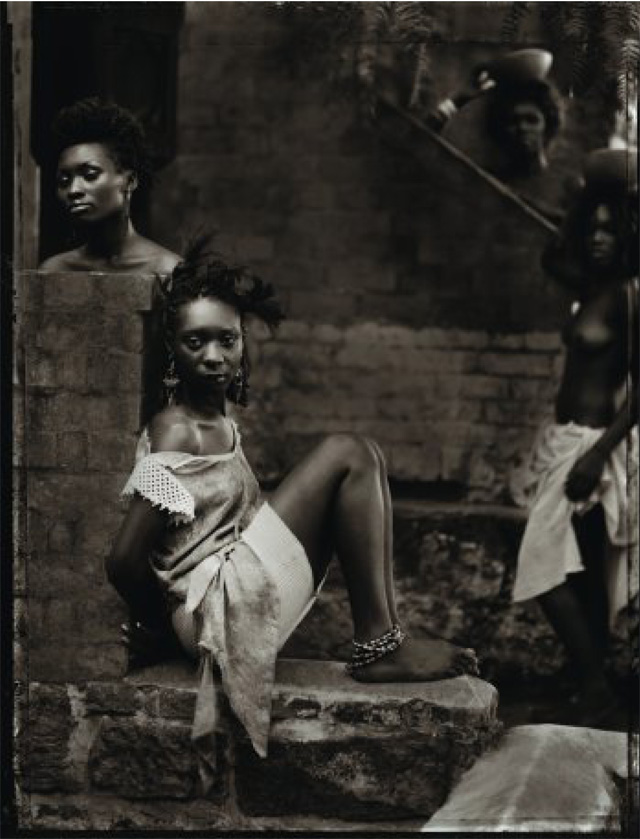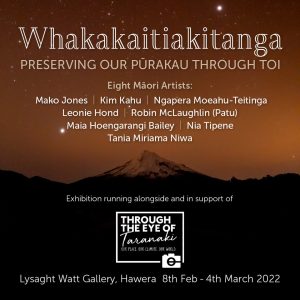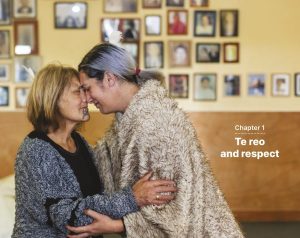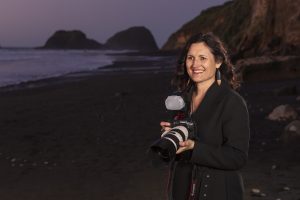
Tania Niwa by Peter Skinner
From the Waitara Marae to Mosman…
Photographers who are able to draw inspiration and strength from their cultural heritage, and who have the talent to infuse their images with the style, character and lore of that ancestry, are indeed fortunate. Such is the case with Tania Niwa, a native of New Zealand now based in Sydney, Australia, who is one of the shining stars of contemporary photography Down Under. Not only has she established herself within the top echelon of Australian photographers in her field, she has also greatly impressed her North American contemporaries at WPPI with powerful, earthy photographs that exude sensuality and incorporate a wonderful blend of documentary and slick design.
Tania’s mainstream portraits—her specialty and principal revenue source—are artistically composed, simply and elegantly lighted, and brilliantly executed. In short, they epitomize contemporary professional environmental portraiture. However, the pictures that made such an impact at WPPI were those that incorporate her Maori heritage in a self-assigned and ongoing series of tribal images. This personal work has truly been a labor of love, and while building and running a successful wedding and portrait business has been demanding, Tania has never wavered from her commitment to the tribal series. She continues to add to the wonderful collection she started more than 12 years ago.
To appreciate how far this talented photographer has come, one needs to touch on her background and appreciate what a powerful influence her ancestral heritage has been in her life, both personally and professionally. The Maori people, the indigenous population of New Zealand, have in recent years made great strides in nurturing and advancing their culture. Tania Niwa, who comes from the small town of Waitara (population 4000) in the Taranaki region of New Zealand’s North Island, was fortunate to be included among those people dedicated to keeping the Maori culture and traditions alive. At a time when many young people spurned the encouragement from their elders to connect with Maoridom and its values, Tania embraced her heritage, and the Waitara Marae became the foundation for her growth. The marae is the cultural and spiritual center of a Maori community, a place where the culture and traditions of the Maori people are maintained and passed on to younger generations. It is, in a sense, the font of Maori knowledge.
Tania explains, “The Waitara Marae ‘Owae-whai-tara’ was, and still remains, a central focus and pride for my small hometown, and it gave me a sense of identity, a direct connection with my ancestors. The marae is strategically placed at one of the highest points in our town, overlooking the Waitara River, which the town was built on both sides of, and has a clear view of the river mouth and the Tasman Sea. Also, it sits before the majestic rise of Mt. Taranaki/Egmont, which belongs to all the tribes of Taranaki and is a very spiritual site for my people.”
From her very beginnings as an artist, Tania drew from the well of her Maori heritage; she used to paint life-size abstract settings replete with Maori symbolism. “I was always passionate about incorporating that heritage into my own style,” she says, “and when I was in my early twenties and looking to develop my photographic tastes, I looked to my cultural background as a source. “When identifying who I am to other Maori, on formal occasions it is traditional to make reference to Taranaki taku Maunga, my mountain, and Waitara taku awa, the name of my river. I do so with a great sense of mana, pride or prestige, attributed to each icon.”
Tania often includes natural objects with spiritual meaning in artwork that otherwise features manmade materials. “For one of my earliest images from the abstract series, I made a window out of polystyrene and added strips of cardboard painted with Maori koru designs. The koru is a symbol of New Zealand, representing a fern frond that symbolizes growth, nurturing and spirituality. I also included a freshly picked fern frond and used that in various ways in a number of images. It helps to understand that a koru is a spiral, representing the fern frond as it opens, bringing new life and purity to the world. It also represents peace, tranquility and spirituality, along with a strong sense of regrowth or new beginnings. The koru is also often associated with nurturing, so when interlocked with other things, it frequently represents the strength and purity of a loving relationship within a family,” she says.
In high school, Tania turned her artistic bent toward photography, and in her final year, she was the discipline’s sole student. Ironically, she became the subject of a front-page shot on the local paper, the Taranaki Herald, for the wrong reasons: The art block of the school, which included Tania’s darkroom and two years worth of her displayed paintings, was destroyed by an act of arson. As Tania sifted through the rubble, a newspaper photographer documented the moment. That photographer was a leading New Zealand photojournalist, Karen Day. Karen would become a mentor to young Tania, guiding her to a career in photography—initially toward photojournalism work with regional newspapers, and later to commercial photography assignments with two leading photographers.
Fortuitously, Tania scored a coup very early in her fledgling career — actually while on a work-experience stint with the Taranaki Herald. Tania was a media-studies student at the Waikato Polytechnic College, and she accompanied a newspaper photographer to her marae for a Maori land-claims hearing. Only under special circumstances and with strict stipulations were photographers allowed to photograph on the marae. The Maori leader ruled that the pakeha (Anglo/Saxon, non- Maori) newspaper photographer could not take photos. On the other hand, Tania, whose father was a respected representative on the marae, understood the rules and was given the privilege of documenting the historic event, which was attended by the governor general of the day, Sir Paul Reeves. Thus, her work appeared on the front page of the Herald.
Like any photographer who has cut his or her teeth on newspapers can appreciate, Tania’s grounding in newspaper photography provided an invaluable foundation for her future career. “The variety of assignments and the opportunity to work with people from so many different backgrounds attracted me to news photography,” she says. “I had to learn how to get the cooperation of so many different people and shoot so many different subjects—dignitaries, sports action and sports personalities, people coping with disasters, and tragic events such as car accidents. Also, we had to do jobs for the paper’s ad department,
such things as secondhand cars and the like. It was all good experience.” Tania’s transition from newspaper photojournalist to wedding/portrait/commercial photographer was greatly influenced by two outstanding photographers with vastly different personalities and modus operandi. Each, in his own way, invaluably furthered her education and career. The first was John Crawford, a longestablished all-around commercial and corporate photographer from New Zealand.
John is based in New Plymouth and renowned for his creativity and unorthodox treatment of traditional subjects. As an example, he did a widely acclaimed series of aerial images—shot from a helicopter — of his wife in unusual locations such as airport runways. Crawford’s eccentricity and artistry were balanced
by his commitment to professionalism, traits that appealed to Tania Niwa. “John liked to show attitude and leading-edge design,” she says. “He was eccentric and would do what was then considered bizarre, such as placing wedding subjects in old ruins and other unusual locations. One shot he did from a helicopter
was of the bride and groom with the bridal party, with the best man next to them lying naked and face down. The location was a large water tank on a farm.
“I absolutely loved working for John, and while with him for about three-and-a-half years, we covered a variety of commercial, corporate and industrial assignments shot on small and medium formats with transparency and black-and-white film. John had an extremely relaxed attitude, even under pressure, and always appreciated what his staff did. Also, he set very high standards,ones that I had always adhered to as well, and he taught me what caliber of photography was expected at a world-class level. He took time to shoot work that was personal, arty and always stimulating.”
Tania’s commercial career took a different direction in 1995, when she worked for Sydney-based photographer Kraig Calstrom, a highly talented and respected industrial photographer whose corporate clients ranged from project and development construction groups, to mining conglomerates and architectural firms. Calstrom was a tough taskmaster whose focused personality and demands were vastly different from Crawford’s. “I worked for Kraig for about 18 months and came close to burning out,” she explains. “The work was interesting but very intense, and we traveled constantly—I think we did 52 flights in one year; we went to Hong Kong seven times and Vietnam twice. We traveled with an enormous amount of equipment—large format cameras, heavy and powerful lighting packs supplemented by a batteryoperated Norman lighting system. I was responsible for the logistics, making sure all the film holders were loaded and unloaded, and all the other things encompassed in shooting big jobs on location in foreign countries. But, while the work was grueling, I did learn about industrial lighting and how to make mundane subjects look interesting, even artistic.”
One gets the distinct impression that Tania’s stint with Kraig Calstrom was not as much fun as her time with John Crawford. But hindsight and analysis of her work with Calstrom make her appreciate just how valuable the experience was from many technical, creative, professional and personal aspects. Perhaps most important, it convinced her that she wanted a career without so much constant and requisite travel, one that encompassed work she could undertake with minimal logistics. And, it had to involve people with whom she enjoyed working. “I am a people person— I love being around people, and I do have this innate ability, maybe it comes from my Maori upbringing, to get people to respond and relax in front of the camera,” she says.
Tania started a wedding and portrait business in Fairlight, on the north side of Sydney, within the exclusive harborside suburb of Mosman—an area whose residents perfectly fit the high-end market Tania had targeted for portrait clients. As with her earlier career, she threw herself into the new business with energy, enthusiasm and a commitment to excellence. She continued activity with trade associations such as the Australian Institute of Professional Photography (AIPP), as she had done in New Zealand (she was the youngest Fellow of the New Zealand Institute of Photography), and became the youngest female photographer to be awarded a prestigious gold bar to the Masters by the AIPP.
In 2004, she reached her third gold bar to Masters and a gold bar to Fellow NZIPP. Eager to learn about happenings in the United States, and having heard glowing reports of WPPI from her peers, she attended the 2006 WPPI conference. She both benefited from the experience, and made a profound impact with her tribal image series.
Tania was awarded such WPPI honors as the Fujifilm New Approach award for excellence in portrait imaging; Grand Award winner in the Premier category, with a first and third place; and the Kodak Award of Distinction for the second-highest scoring portfolio overall. A devotee of available light, Tania imbues her work with warm, natural illumination. Lately she has been shooting at higher ISOs,on the order of 1000 to 1250, and capitalizing on the quality of digital imaging at those speeds.
Tania shoots with Canon EOS-1Ds Mark II and EOS-1D Mark IIn cameras. When needed, she will supplement ambient light with modeling lights, taking advantage of their warm characteristics. When shooting outdoors, always in the shade, she uses subtle fill flash to add sparkle to catchlights. No amount of setup is too much trouble to produce excellent images and satisfy clients. “My approach reflects the perfectionist attitude I have always had, and I am dedicated to capturing the personality of my subjects in what I’ve promoted in our business as ‘a work of fine art.’ Our clients are always spoiled when it comes to choice, and I like to think they regard us as a company that will produce timeless works of art for them.
Whatever we do, they seem to like it and keep coming back,” she says. Tania’s studio manager, Lauren Miles, is a real asset to the advancement of what will soon be renamed Niwa and Associates Photographers, Ltd. Tania and Lauren have definite ideas on what the future will hold for the thriving wedding and portrait business. While Tania is a successful and highly accomplished wedding photographer, she wants to scale back on that side of the business to concentrate on high-end portraiture. “We are developing our corporate portraiture more actively, rather than just doing it when requested,” she says. “Our family portrait clients are all in big corporations, so we want to make the most of those connections.”
Clients will be serviced by two additional photographers hired to specialize in that area. Additionally, Lauren and Tania have launched into consulting other wedding photographers in their area. “We both enjoy this and want to develop our consulting much more so it becomes a major part of the business. Our strengths are our image, branding and sales techniques,” says Tania. “The plan is to have a business that runs beautifully and profitably without me having to be involved in all the day-to-day matters. That will allow me to be selective in what I shoot—I like the idea of one portrait a week, perhaps forty times a year.”
Tania recently made contact with leading New Zealand artist Darcy Nicholas, who was influential in establishing the New Zealand- San Francisco Association (NZSFA) to promote cultural,artistic, and educational exchange programs between the two locales, with an emphasis on promoting New Zealand and Maori art. Tania is looking forward to contributing to NZSFA, helping it meet its goals while possibly contributing her own work to the exhibition program. Also high on Tania’s list of future priorities is adding to her portfolio of tribal images. From the very beginnings of her career as an artist and photographer, she has capitalized on, and been eternally grateful for, being born into a proud and traditional culture that has become the foundation for her personal and
professional aspirations. Deep down, she knows she can play her part in paying tribute to, and advancing, that Maori heritage through her groundbreaking photography. To see more of Tania Niwa’s work, visit www. tanianiwa.com.au.
Tani Niwa will present a program at WPPI 2007 entitled “Image, Branding & Sales for the Portrait Studio.”
Freelance writer/photographer and author Peter Skinner has more than 22 years experience in the photo industry in public relations, media liaison, corporate communications and workshop production and coordination. His magazine articles and photography have been published internationally and he has co-authored or edited numerous publications and books. He collaborated with the late Don Blair on The Art of Seeing Light (Amherst Media). He can be reached at [email protected].



